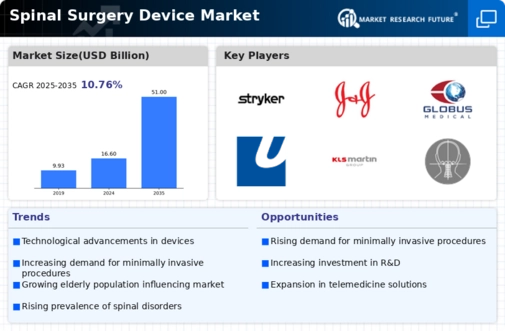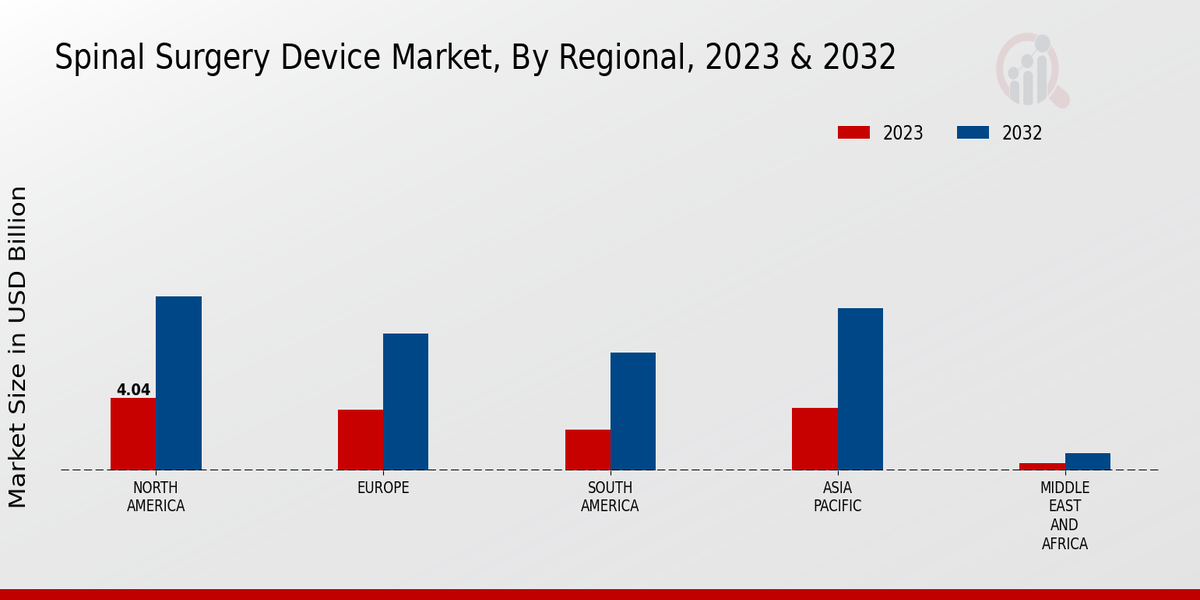Market Growth Projections
The Global Spinal Surgery Device Market Industry is poised for remarkable growth, with projections indicating a rise from 16.6 USD Billion in 2024 to 51.0 USD Billion by 2035. This growth trajectory reflects a compound annual growth rate (CAGR) of 10.76% from 2025 to 2035. Factors contributing to this expansion include technological advancements, increasing prevalence of spinal disorders, and enhanced healthcare infrastructure. As the market evolves, it is likely to witness the introduction of innovative devices and surgical techniques, further driving demand and improving patient outcomes.
Rising Prevalence of Spinal Disorders
The increasing incidence of spinal disorders globally drives the Global Spinal Surgery Device Market Industry. Conditions such as degenerative disc disease, spinal stenosis, and scoliosis are becoming more prevalent, particularly among aging populations. For instance, the World Health Organization indicates that musculoskeletal disorders, including spinal issues, affect millions worldwide. This surge in spinal disorders necessitates advanced surgical interventions, thereby propelling the demand for spinal surgery devices. As a result, the market is projected to reach 16.6 USD Billion in 2024, with a substantial contribution from surgical procedures aimed at alleviating pain and restoring mobility.
Aging Population and Increased Life Expectancy
The global demographic shift towards an aging population significantly influences the Global Spinal Surgery Device Market Industry. As life expectancy increases, age-related spinal disorders are becoming more common, necessitating surgical interventions. The United Nations projects that by 2050, the number of people aged 60 and older will double, leading to a higher incidence of conditions requiring spinal surgery. This demographic trend drives demand for spinal surgery devices, as older adults often experience degenerative changes in their spine. Consequently, the market is poised for substantial growth, with a projected value of 51.0 USD Billion by 2035, reflecting the need for effective surgical solutions.
Technological Advancements in Surgical Techniques
Innovations in surgical techniques and technologies are transforming the Global Spinal Surgery Device Market Industry. Minimally invasive surgery, robotic-assisted procedures, and advanced imaging techniques enhance surgical precision and patient outcomes. These advancements not only reduce recovery times but also minimize complications associated with traditional open surgeries. For example, the adoption of robotic systems in spinal surgeries has shown promising results in improving accuracy and reducing hospital stays. As these technologies continue to evolve, they are likely to attract more healthcare providers, further expanding the market, which is expected to grow significantly, reaching 51.0 USD Billion by 2035.
Growing Awareness and Acceptance of Spinal Surgery
The rising awareness and acceptance of spinal surgery among patients and healthcare providers are pivotal for the Global Spinal Surgery Device Market Industry. Educational campaigns and improved access to information have empowered patients to seek surgical options for spinal disorders. Additionally, endorsements from healthcare professionals regarding the efficacy of surgical interventions contribute to this trend. As patients become more informed about the benefits of spinal surgery, the demand for advanced spinal devices is likely to increase. This shift in perception is expected to drive market growth, aligning with the projected CAGR of 10.76% from 2025 to 2035.
Increasing Investment in Healthcare Infrastructure
The expansion of healthcare infrastructure globally is a crucial driver for the Global Spinal Surgery Device Market Industry. Governments and private sectors are investing heavily in modernizing hospitals and surgical centers, particularly in developing regions. This investment facilitates the acquisition of advanced spinal surgery devices and technologies, enhancing the overall quality of care. For instance, initiatives to improve surgical facilities in Asia-Pacific and Latin America are likely to increase access to spinal surgeries, thereby boosting market growth. As healthcare systems evolve, the demand for innovative spinal surgery solutions is expected to rise, contributing to a projected CAGR of 10.76% from 2025 to 2035.






















